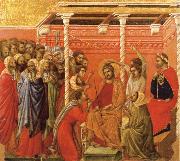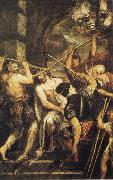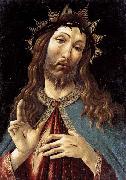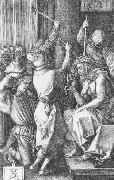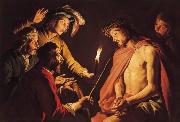
|
Duccio di Buoninsegna
|
|||
|
|
|||
| 1255-1318 Italian Duccio di Buoninsegna Locations Italian painter. He was one of the most important painters of the 14th century and like his slightly younger contemporary, Giotto, was a major influence on the course of Italian painting. An innovator, he introduced into Sienese painting new altarpiece designs, a dramatic use of landscape, expressive emotional relationships, extremely complex spatial structures and a subtle interplay of colour. His most important and revolutionary work, the Maeste for Siena Cathedral, was never matched during the 14th century, if at all, and his influence lasted well into the 15th century. | |||
|
|
|||
|
Christ Crowned with Thorns new9/Duccio di Buoninsegna-723429.jpg Painting ID:: 33275 |
mk83 1308-1311 Tempera and oil on wood 50x53.5cm | ||
|
|
|||
|
Titian
|
|||
|
|
|||
| Italian High Renaissance Painter, ca.1485-1576 Italian painter active in Venice. As a young man he was taught by the Bellini family and worked closely with Giorgione. His early works are so similar in style to Giorgione's as to be indistinguishable, but soon after Giorgione's early death Titian established himself as the leading painter of the Republic of Venice. Among his most important religious paintings is the revolutionary and monumental Assumption (1516 ?C 18) for Santa Maria dei Frari, in which the Virgin ascends to heaven in a blaze of colour accompanied by a semicircle of angels. Titian was also interested in mythological themes, and his many depictions of Venus display his work's sheer beauty and inherent eroticism. Bacchus and Ariadne (1520 ?C 23), with its pagan abandon, is one of the greatest works of Renaissance art. Titian was sought after for his psychologically penetrating portraits, which include portrayals of leading Italian aristocrats, religious figures, and Emperor Charles V. He reached the height of his powers in The Rape of Europa (c. 1559 ?C 62), one of several paintings done for Philip II of Spain. He was recognized as supremely gifted in his lifetime, and his reputation has never declined. | |||
|
|
|||
|
Christ Crowned with Thorns new9/Titian-952425.jpg Painting ID:: 33493 |
mk86 c.1576 Oil on canvas 280x182cm Munich,Bayerische Staatsgemalde-sammlungen,Alte Pinakothek | ||
|
|
|||
|
BOTTICELLI, Sandro
|
|||
|
|
|||
| Italian Early Renaissance Painter, 1445-1510 Alessandro di Mariano di Vanni Filipepi, better known as Sandro Botticelli or Il Botticello ("The Little Barrel"; March 1, 1445 ?C May 17, 1510) was an Italian painter of the Florentine school during the Early Renaissance (Quattrocento). Less than a hundred years later, this movement, under the patronage of Lorenzo de' Medici, was characterized by Giorgio Vasari as a "golden age", a thought, suitably enough, he expressed at the head of his Vita of Botticelli. His posthumous reputation suffered until the late 19th century; since then his work has been seen to represent the linear grace of Early Renaissance painting, and The Birth of Venus and Primavera rank now among the most familiar masterpieces of Florentine art. Details of Botticelli's life are sparse, but we know that he became an apprentice when he was about fourteen years old, which would indicate that he received a fuller education than did other Renaissance artists. Vasari reported that he was initially trained as a goldsmith by his brother Antonio. Probably by 1462 he was apprenticed to Fra Filippo Lippi; many of his early works have been attributed to the elder master, and attributions continue to be uncertain. Influenced also by the monumentality of Masaccio's painting, it was from Lippi that Botticelli learned a more intimate and detailed manner. As recently discovered, during this time, Botticelli could have traveled to Hungary, participating in the creation of a fresco in Esztergom, ordered in the workshop of Fra Filippo Lippi by Vitez J??nos, then archbishop of Hungary. By 1470 Botticelli had his own workshop. Even at this early date his work was characterized by a conception of the figure as if seen in low relief, drawn with clear contours, and minimizing strong contrasts of light and shadow which would indicate fully modeled forms. | |||
|
|
|||
|
Christ Crowned with Thorns new16/BOTTICELLI, Sandro-262472.jpg Painting ID:: 44275 |
c. 1500 Tempera on panel, 47,6 x 32,3 cm | ||
|
|
|||
|
Albrecht Durer
|
|||
|
|
|||
| b.May 21, 1471, Imperial Free City of Nernberg [Germany] d.April 6, 1528, Nernberg Albrecht Durer (May 21, 1471 ?C April 6, 1528) was a German painter, printmaker and theorist from Nuremberg. His still-famous works include the Apocalypse woodcuts, Knight, Death, and the Devil (1513), Saint Jerome in his Study (1514) and Melencolia I (1514), which has been the subject of extensive analysis and interpretation. His watercolours mark him as one of the first European landscape artists, while his ambitious woodcuts revolutionized the potential of that medium. D??rer introduction of classical motifs into Northern art, through his knowledge of Italian artists and German humanists, have secured his reputation as one of the most important figures of the Northern Renaissance. This is reinforced by his theoretical treatise which involve principles of mathematics, perspective and ideal proportions. His prints established his reputation across Europe when he was still in his twenties, and he has been conventionally regarded as the greatest artist of the Renaissance in Northern Europe ever since. | |||
|
|
|||
|
Christ Crowned with Thorns new21/Albrecht Durer-872864.jpg Painting ID:: 63605 |
1512 Engraving, 118 x 74 mm Art Museum, Princeton Sheet No. 7 of the Engraved Passion. Christ is shown in profile, yet quite differently from the woodcut versions of this subject. This is richer and more picturesque. Nevertheless, greater clarity is not quite achieved. The similarity of the spatial arrangement to the Flagellation can be observed. Pilate is seen in the background, standing next to Caiaphas. The bald bearded man is reminiscent of Italian model heads.Artist:D?RER, Albrecht Title: Christ Crowned with Thorns (No. 7) Painted in 1501-1550 , German - - graphics : religious | ||
|
|
|||
|
Matthias Stomer
|
|||
|
|
|||
| Amersfoort ca.1600-Sicily after 1650 | |||
|
|
|||
|
Christ Crowned with Thorns new23/Matthias Stomer-493733.jpg Painting ID:: 70599 |
Medium Oil on canvas Dimensions 110.8 x 161 cm | ||
|
|
|||
|
Also Buy::. For Following Paintings / Artists / Products, Please Use Our Search Online: |






